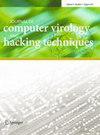具有组合解密指数的RSA密码分析,其中一个素数的最高有效位很少
IF 1.9
Q3 COMPUTER SCIENCE, INFORMATION SYSTEMS
Journal of Computer Virology and Hacking Techniques
Pub Date : 2023-10-20
DOI:10.1007/s11416-023-00508-8
引用次数: 0
摘要
RSA是现代密码学中著名的公钥密码系统。自RSA诞生以来,已经提出了几种针对RSA的攻击。Boneh-Durfee攻击是最突出的,他们表明,如果秘密指数小于0.292,RSA是完全脆弱的。在本文中,我们进一步研究了当一个秘密指数很大时RSA的脆弱性,以及暴露其中一个素数的几个最高有效位的复合形式。大的秘密指数可以避免Boneh-Durfee攻击,但在这次攻击中,我们证明了即使秘密指数很大,并且有一些特殊的结构,RSA仍然是脆弱的。我们遵循Jochemsz和May策略来构造晶格,并使用LLL算法进行晶格约简。我们的攻击比以前的大多数攻击都有效。本文章由计算机程序翻译,如有差异,请以英文原文为准。
Cryptanalysis of RSA with composed decryption exponent with few most significant bits of one of the primes
RSA is well known public-key cryptosystem in modern-day cryptography. Since the inception of the RSA, several attacks have been proposed on RSA. The Boneh–Durfee attack is the most prominent and they showed that if the secrete exponent is less than 0.292, RSA is completely vulnerable. In this paper, we further investigate the vulnerability of RSA whenever a secret exponent is large and the composite form with a few most significant bits of one of the primes exposed. Having a large secret exponent can avoid the Boneh–Durfee attack, but in this attack, we show that even though the secret exponent is large and has some specialized structure then RSA is still vulnerable. We follow the Jochemsz and May strategy for constructing the lattice, and the LLL algorithm is used for lattice reduction. Our attack outperforms most of the previous attacks.
求助全文
通过发布文献求助,成功后即可免费获取论文全文。
去求助
来源期刊

Journal of Computer Virology and Hacking Techniques
COMPUTER SCIENCE, INFORMATION SYSTEMS-
CiteScore
4.00
自引率
13.30%
发文量
41
期刊介绍:
The field of computer virus prevention has rapidly taken an important position in our technological and information society. Viral attacks increase year after year, and antiviral efforts continually face new challenges. Beneficial applications of technologies based on scientific computer virology are still very limited. The theoretical aspects of the virus problem are only rarely considered, although many interesting and important open problems still exist. Little proactive research is focused on predicting the future of viral attacks.The Journal of Computer Virology and Hacking Techniques is an independent scientific and technical journal dedicated to viral and antiviral computer technologies. Both theoretical and experimental aspects will be considered; papers emphasizing the theoretical aspects are especially welcome. The topics covered by this journal include, but are certainly not limited to:- Mathematical aspects and theoretical fundamentals of computer virology - Algorithmics and computer virology - Computer immunology and biological models for computers - Reverse engineering (hardware and software) - Viral and antiviral technologies - Cryptology and steganography tools and techniques - Applications in computer virology - Virology and IDS - Hardware hacking, and free and open hardware - Operating system, network, and embedded systems security - Social engineeringIn addition, since computational problems are of practical interest, papers on the computational aspects of computer virology are welcome. It is expected that the areas covered by this journal will change as new technologies, methodologies, challenges and applications develop. Hacking involves understanding technology intimately and in depth in order to use it in an operational way. Hackers are complementary to academics in that they favour the result over the methods and over the theory, while academics favour the formalization and the methods -- explaining is not operating and operating is not explaining. The aim of the journal in this respect is to build a bridge between the two communities for the benefit of technology and science.The aim of the Journal of Computer Virology and Hacking Techniques is to promote constructive research in computer virology by publishing technical and scientific results related to this research area. Submitted papers will be judged primarily by their content, their originality and their technical and scientific quality. Contributions should comprise novel and previously unpublished material.However, prior publication in conference proceedings of an abstract, summary, or other abbreviated, preliminary form of the material should not preclude publication in this journal when notice of such prior or concurrent publication is given with the submission. In addition to full-length theoretical and technical articles, short communications or notes are acceptable. Survey papers will be accepted with a prior invitation only. Special issues devoted to a single topic are also planned.The policy of the journal is to maintain strict refereeing procedures, to perform a high quality peer-review of each submitted paper, and to send notification to the author(s) with as short a delay as possible. Accepted papers will normally be published within one year of submission at the latest. The journal will be published four times a year.
Note: As far as new viral techniques are concerned, the journal strongly encourages authors to consider algorithmic aspects rather than the actual source code of a particular virus. Nonetheless, papers containing viral source codes may be accepted provided that a scientific approach is maintained and that inclusion of the source code is necessary for the presentation of the research. No paper containing a viral source code will be considered or accepted unless the complete source code is communicated to the Editor-in-Chief. No publication will occur before antiviral companies receive this source code to update/upgrade their products.The final objective is, once again, proactive defence.This journal was previously known as Journal in Computer Virology. It is published by Springer France.
 求助内容:
求助内容: 应助结果提醒方式:
应助结果提醒方式:


